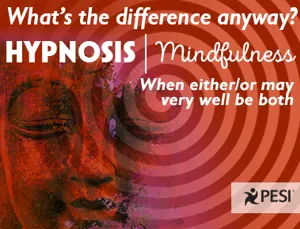Mindfulness Vs. Hypnosis

What is the difference between “mindfulness” and “hypnosis,” anyway? Sometimes clients are asking because they are curious, but other times they are looking for the right referral. Clients (and therapists making referrals) are usually fairly certain that they want one or the other. They feel that either hypnosis or mindfulness is what is needed. You want to stop smoking? Hypnosis. You want to calm down? Mindfulness. It is usually either/or, though the presenting issue may very well be both.
Though we may not want to admit it, our field is dominated by trends and buzz words that encourage interests and fads. As a result, referral choices and treatment approaches are also often driven by what is trending instead of what really works best for our clients. The search for suitable treatment is frequently confined to the latest fashions, when careful exploration and consideration of all available options is warranted. Clients are complex and no one “style” meets everyone’s needs.
Back to mindfulness and hypnosis. I am struck by how these tools are, in fact, more similar than different. Both approaches are efficacious when coping with anxiety, depression, and stress. Both invite the person to pay close attention to the internal process that is experienced at a given time, to be fully present in the moment and absorbed in the experience. Self-awareness is specifically welcomed as clients notice the sensations taking place inside the body, the breath, emotional manifestations, and physiological reactions. This inward focus allows clients to amplify positive experiences while simultaneously diminishing painful ones, including the kind of thinking that can easily be distorted when one is under duress.
If I were speaking exclusively to hypnotherapists, heads would nod in agreement, and we would go on to discuss the depths of experience one has while engaged in a state of trance. If I were speaking to mindfulness practitioners, there would also be indications of agreement, and we would continue to explore ideas about nonjudgmental awareness and living in the present moment.
Nuances on a basic theme? For me, the answer is yes. My intent is to help my clients make the adjustments necessary to feel a sense of deep internal alignment. Frequently, symptoms — and ways to tamp them down — arise due to self-deception and the defenses that are utilized to avoid the truth. This applies to most presenting problems at the onset of treatment, especially regarding illness, pain management, out-of-control behaviors, psychodynamic issues, sexual issues, and others. Returning to the first example, is there not some connection between wanting to stop smoking and the need to feel more peaceful?
In our fast-paced digitally driven world of stress and chaos, our clients have an ever greater need to slow down, to unplug externally, and to plug in internally. The best way to do this involves incorporating mind-body techniques that meet the range of mind-bodies! I was trained in hypnotherapy, and have over time evolved a process that invites a creative collaboration with my clients. Attuning to their rhythms and interests, I create scripts that incorporate both their issues and burgeoning resources. This is how I define my “hypnosis work,” but it is also the territory of most mindfulness practice.
Having Fun While Experimenting
One of my passions in my clinical work is leading groups. I thrive on bringing people together to recognize similarities, support each other, and to experience the interpersonal power that emerges while deepening connections with others and with oneself. The synergy of groups is magical. Aside from leading long-term psychotherapy groups, I also offer 8-week experiential psycho-educational groups focusing on ego strengthening, self-mastery, and achieving internal success, emphasizing mind body techniques. This model has proven successful for many clients. Some folks join seeking to explore mindfulness, some have specific problems or symptoms to work on, and still others are simply intrigued by the opportunities for self-exploration that are offered.
Though using the same basic curriculum, I have alternated between referring to the groups as hypnosis and mindfulness. I was interested, in part, in which label would draw more participants, and was pleasantly surprised to find that it didn’t matter!
Lesson learned, the success of our work is less contingent upon what is trending, and more related to the degree to which we are trusted and accepted by our clients and other therapists, and how our own sense of positive expectancy encourages clients. Attributes like trustworthiness are not fleeting styles.
Okay, Though, Which Is It?
I usually refer to my work as “clinical hypnosis,” but sometimes I may simply say meditation or guided meditation, mindfulness, or relaxation exercises. This latitude in language stems from clients describing my work in myriad ways and my taking the pulse by imagining which word will most appeal to a client’s sensibilities. I am happy to use the client’s preferred language — part of attunement — and I know that my approach is essentially all of those things.
Unfortunately, stage hypnosis really made its mark on people’s thinking about hypnosis in general. Those of us who are hypnotherapists regularly need to educate clients (and other clinicians) that the hypnosis we provide is not based on what one sees in entertainment circles, but is a tool employed to deepen the wider process of psychotherapy. Since, mindfulness is now a part of common parlance, it is a bit easier in some ways to describe hypnosis, to chip away at the stage hypnosis image: Mindfulness and Hypnosis are not exactly the same procedures and yet they are used to work with the same part of the human landscape.
As a contemporary clinician, it is important to me to acknowledge my own biases as far as the paradigms that appeal to me. However, it is equally important to not allow those preferences to become stagnant and rarified. I believe we need to stay up to date, not threatened by new trends, willing to explore them, listen to their pioneers, understand their similarities as well as their differences. At the same time, what is new doesn’t need to replace the tried and true, but can be seen as an addition or augmentation. This continuing education is part of my practice. And, referrals are part of my practice. I see myself as being on a client’s team of resources.
Did I answer my opening question about the difference between Mindfulness and Hypnosis? They are different — and they are not. Just as the two clients who come to you with anxiety are presenting with something different — and not. It is essential to keep refining and simultaneously broadening the language of treatment even as we continue to strengthen its core elements of trustworthiness, rapport, and self-care.
Rick Miller, LICSW, is a clinical social worker in private practice in Boston and on Cape Cod, Massachusetts with over 30 years of experience. His first book, Unwrapped: Integrative Therapy with Gay Men, was published in 2014, and he was a contributing author to the book For Couples: Ten Commandments for Every Aspect of Your Relationship Journey (2011). Mr. Miller’s popular blog, Unwrapped: Mind-Body Wisdom and the Modern Gay Man, is featured on PsychologyToday.com, and his work has appeared in Psychotherapy Networker as well as Somatic Psychotherapy Today.
You can purchase his most recent book, Mindfulness Tools for Gay Men In Therapy: A Clinician's Guide for Mind-Body Wellness, from PESI.




